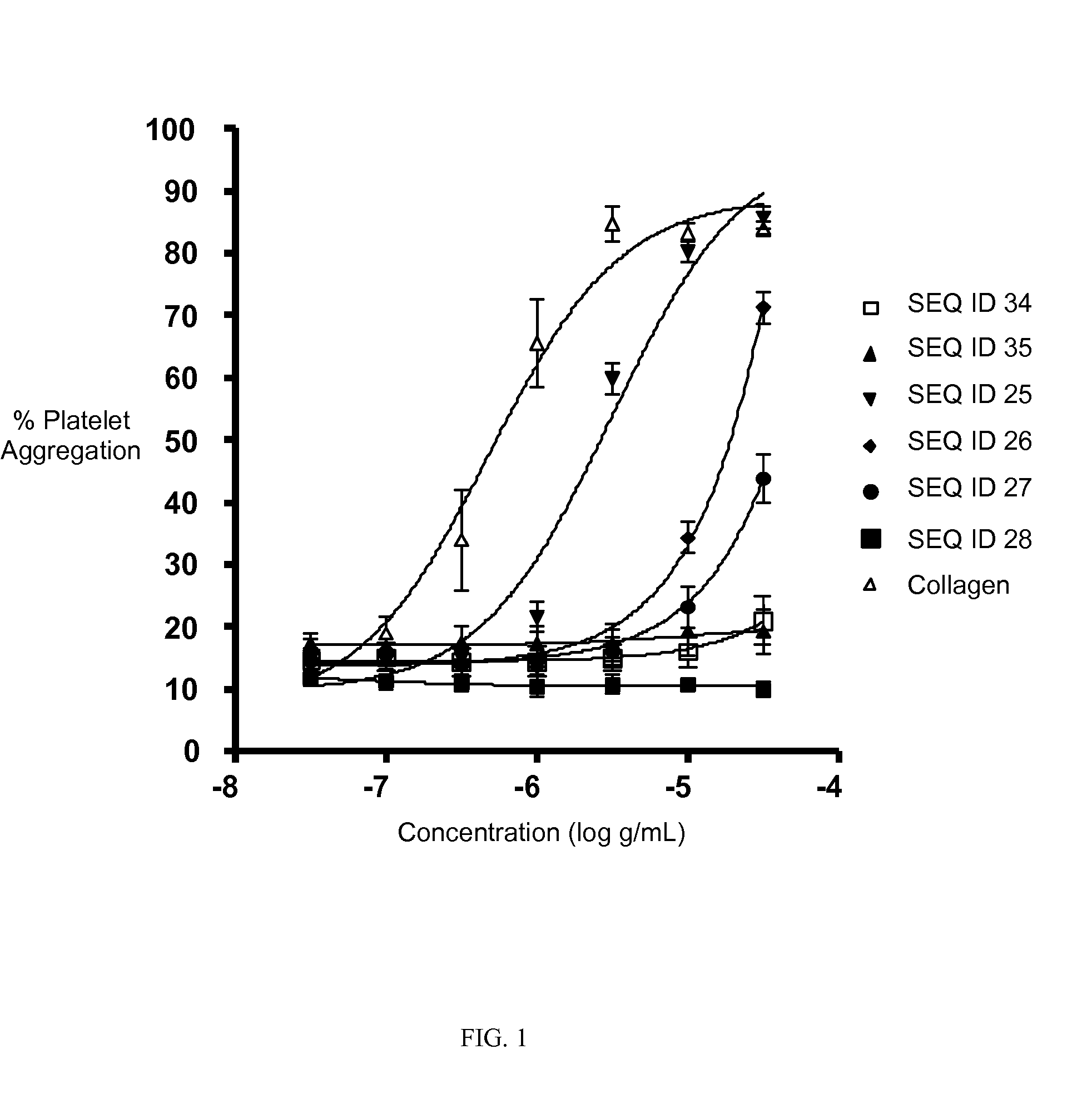Collagen-related peptides and uses thereof
a technology of collagen-related peptides and peptides, which is applied in the field of collagen-related peptides, can solve the problems of difficult synthesis and purification, and insufficient thermal stability of triple-helices to survive at physiological conditions
- Summary
- Abstract
- Description
- Claims
- Application Information
AI Technical Summary
Benefits of technology
Problems solved by technology
Method used
Image
Examples
example 1
[0154]
SEQ ID 25:(F5)-Phe-(Gly-Pro-Hyp)10-PheComparator SEQ ID 29:Ac-(Gly-Pro-Hyp)10-GlyComparator SEQ ID 35:F5Phe-(Gly-Pro-Hyp)5-Phe
[0155]The CRP having SEQ ID 25 and comparator polypeptides having SEQ ID 29 and SEQ ID 35 were synthesized by standard FastMoc chemistry, purified by reversed-phase HPLC and characterized.
[0156]The CRP having SEQ ID 25 was synthesized on an ABI 431 synthesizer using FastMoc chemistry (0.1 mmol scale) and Fmoc-Phe-Wang resin (0.74 mmol / g, 100-200 mesh). The CRP was cleaved from the resin with TFA / triisopropylsilane / water (95:2.5:2.5) for 2 h. HPLC purification was performed in a Phenomenex C-18 reverse-phase column (25×5 cm), using a linear gradient of 10-95% B (A: 0.2% TFA / H2O; B: 0.16% TFA / MeCN) over 60 min at a flow rate of 50 mL / min. The CRP was obtained as a white powder in 32% overall yield. For SEQ ID 25: (F5)-Phe-(Gly-Pro-Hyp)10-Phe: MALDI-TOF-MS (M+Na)+ calcd for C138H185F5N32O43, 3096.3; found, 3096.8. The comparator polypeptide having SEQ ID 3...
example 2
[0164]
SEQ ID 25:F5Phe-(Gly-Pro-Hyp)10-PheSEQ ID 26:Phe-(Gly-Pro-Hyp)10-PheSEQ ID 27:Leu-(Gly-Pro-Hyp)10-PheSEQ ID 28:Gly-(Gly-Pro-Hyp)10-Gly.
[0165]The CRPs having SEQ ID 25, SEQ ID 26, and SEQ ID 27 and the comparator polypeptide having SEQ ID 28 were synthesized by standard FastMoc chemistry, purified by reversed-phase HPLC, and characterized.
Peptide Synthesis
[0166]The CRPs having SEQ ID 25, SEQ ID 26 and SEQ ID 27 and the comparator polypeptide having SEQ ID 28 were synthesized on an ABI 431 synthesizer using FastMoc chemistry (0.1 mmol scale) and Fmoc-Phe-Wang resin (0.74 mmol / g, 100-200 mesh) or Fmoc-Gly-Wang resin (0.66 mmol / g, 100-200 mesh). The CRPs and polypeptide were cleaved from the resin with TFA / triisopropylsilane / water (95:2.5:2.5) for 2 h. Purification was performed by RP-HPLC (Zorbax 300 SB-C18, 21.2×150 mm, at 60° C.) using a linear gradient of 5-95% B (A: 0.05% TFA / water; B: 0.05% TFA / MeCN) over 15 min at a flow rate of 20 mL / min. The fractions were analyzed by LC / ...
example 3
[0170]
SEQ ID 31:F5Phe-(Gly-Pro-Hyp)9-PheSEQ ID 32:Phe-(Gly-Pro-Hyp)9-PheSEQ ID 33:Leu-(Gly-Pro-Hyp)9-Phe
[0171]As more fully described below, the model structure for a CRP trimer of the present invention was constructed from the X-ray structure of the collagen-like polypeptide trimer having SEQ ID 30: (Pro-Hyp-Gly)4-(Pro-Hyp-Ala)-(Pro-Hyp-Gly)5 (Bella J, Eaton M, Brodsky B and Berman H M, Science 1994, 266, 75-81). The collagen-like polypeptide trimer having SEQ ID 30 was mutated to incorporate F5Phe at the N-terminus (Pro-position) and Phe at the C-terminus (Gly-position) to provide a CRP having SEQ ID 31 (similar to SEQ ID 25, but lacking one GPO repeat). Polypeptides having SEQ ID 32 and SEQ ID 33 were similarly prepared using Phe and Leu, respectively.
[0172]The crystal structure of the collagen-like polypeptide having SEQ ID 30 was used as the starting point for modeling. Since this structure contained a central alanine residue, the residue was first mutate...
PUM
| Property | Measurement | Unit |
|---|---|---|
| thickness | aaaaa | aaaaa |
| pore size | aaaaa | aaaaa |
| thickness | aaaaa | aaaaa |
Abstract
Description
Claims
Application Information
 Login to View More
Login to View More - R&D
- Intellectual Property
- Life Sciences
- Materials
- Tech Scout
- Unparalleled Data Quality
- Higher Quality Content
- 60% Fewer Hallucinations
Browse by: Latest US Patents, China's latest patents, Technical Efficacy Thesaurus, Application Domain, Technology Topic, Popular Technical Reports.
© 2025 PatSnap. All rights reserved.Legal|Privacy policy|Modern Slavery Act Transparency Statement|Sitemap|About US| Contact US: help@patsnap.com


